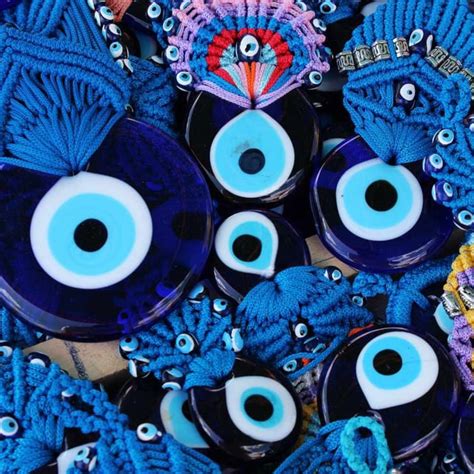The red evil eye, an iconic symbol that has haunted cultures for centuries, is believed to possess the power to cast curses and inflict misfortune upon those who come into its path. Its malevolent presence has been woven into folklore, religion, and art, leaving an enduring mark on human imagination.

Historical Origins and Cultural Significance
The origins of the red evil eye can be traced back to ancient Mesopotamia, where it was depicted on amulets and talismans as a protective symbol against envy and harm. Over time, it spread throughout the Mediterranean region and into Europe, Asia, and Africa, becoming a ubiquitous symbol of warding off evil spirits.
In many cultures, the color red was associated with danger, blood, and malevolence. The combination of the evil eye and the color red thus created a potent image of fear and superstition. People believed that a person with an “evil eye” possessed the ability to cast curses, cause illness, or even death by casting their gaze upon others.
Manifestations of the Red Evil Eye
The red evil eye is often depicted as a stylized eye with a red iris, surrounded by concentric circles or rays. It may be incorporated into jewelry, artwork, textiles, and architecture. In some societies, it is believed that the red evil eye can be inherited or acquired through malicious intent.
People who believe in the evil eye often take precautions to protect themselves. They wear amulets or charms adorned with the evil eye symbol, or recite incantations and prayers to ward off its influence.
Scientific Explorations and Skepticism
Despite its widespread cultural significance, scientific evidence for the existence of the red evil eye is lacking. Skeptics argue that any perceived effects of the evil eye are more likely due to psychological factors, such as confirmation bias and the power of suggestion.
However, the belief in the evil eye persists in many communities around the world, offering a glimpse into the complex interplay between superstition, fear, and the human psyche.
Applications in Contemporary Art and Design
The red evil eye has gained renewed interest in contemporary art and design. Artists have incorporated the symbol into paintings, sculptures, and installations, exploring its cultural significance and aesthetic appeal.
Fashion designers have also embraced the red evil eye, using it as a statement piece on clothing, accessories, and jewelry. It has become a symbol of both protection and individuality.
Benefits and Considerations
-
Protection from misfortune: The red evil eye is believed to ward off curses and other forms of bad luck.
-
Cultural heritage: The evil eye is a symbol with a rich cultural history and can connect people to their ancestral traditions.
-
Aesthetic appeal: The unique and eye-catching design of the red evil eye makes it an attractive addition to art and fashion.
-
Controversy: The belief in the evil eye may be seen as superstitious or irrational by some, while others find comfort and protection in it.
Tables for Further Exploration
1. Cultural Variations of the Red Evil Eye
| Region | Symbolism | Protection Methods |
|---|---|---|
| Mediterranean | Envy, misfortune | Amulets, blue glass beads |
| Middle East | Power of the gaze | Charms, prayers |
| Asia | Curses, illness | Red thread bracelets, avoidance |
| Africa | Witchcraft, protection | Talismans, herbal remedies |
2. Historical Uses of the Red Evil Eye
| Ancient Civilization | Purpose | Examples |
|---|---|---|
| Mesopotamia | Protection from demons | Amulets, statues |
| Greece | Repelling curses | Vases, jewelry |
| Roman Empire | Warding off evil spirits | Artifacts, mosaics |
| Islamic World | Protecting against the “evil eye” | Glass beads, embroidery |
3. Applications in Contemporary Art
| Artist | Work | Medium |
|---|---|---|
| Frida Kahlo | “The Wounded Deer” | Painting |
| Yayoi Kusama | “Infinity Mirrors” | Installation |
| Damien Hirst | “For the Love of God” | Sculpture |
| Kara Walker | “A Subtlety, or the Marvelous Sugar Baby” | Installation |
4. Benefits and Considerations of the Red Evil Eye
| Benefit | Consideration |
|---|---|
| Protection from misfortune | May be seen as superstitious |
| Cultural heritage | May be controversial |
| Aesthetic appeal | May not appeal to everyone |
| Personal expression | May vary in significance across cultures |
Frequently Asked Questions
-
Can the evil eye really harm me? While there is no scientific evidence to support this, many cultures believe that the evil eye can cause misfortune or even illness.
-
How can I protect myself from the evil eye? Wearing amulets or charms adorned with the evil eye symbol is a common practice to ward off its influence.
-
Is it appropriate to wear the evil eye symbol if I don’t believe in it? Some people wear the evil eye as a cultural symbol or fashion statement, regardless of their personal beliefs.
Conclusion
The red evil eye, a symbol steeped in centuries of superstition and fear, continues to captivate and intrigue people around the world. While its existence may be disputed, its cultural significance and enduring presence in art and design are undeniable. Whether you view it as a powerful talisman or an object of fascination, the red evil eye remains a potent reminder of the human mind’s capacity for both superstition and the desire for protection.
